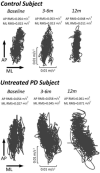Postural sway as a marker of progression in Parkinson's disease: a pilot longitudinal study
- PMID: 22750016
- PMCID: PMC3894847
- DOI: 10.1016/j.gaitpost.2012.04.010
Postural sway as a marker of progression in Parkinson's disease: a pilot longitudinal study
Abstract
Objective measures of postural control that are sensitive to Parkinson's disease (PD) progression would improve patient care and accelerate clinical trials. Although measures of postural sway during quiet stance in untreated PD have been shown to differ from age-matched control subjects, it is not known if sway measures change with disease progression in early PD. In this pilot study, we asked whether accelerometer-based metrics of sway could provide a practical tool for monitoring progression of postural dyscontrol in people with untreated or newly treated PD. We examined 13 subjects with PD and 12 healthy, age-matched control subjects. The PD subjects had been recently diagnosed and had not started any antiparkinsonian medications at the baseline session. All subjects were tested 3-6 months and 12 months after the baseline session. Subjects were asked to stand quietly for two minutes while wearing an inertial sensor on their posterior trunk that measured trunk linear acceleration. Our results suggested that objective sway measures deteriorated over one year despite minimal changes in UPDRS motor scores. Medio-lateral (ML) sway measures were more sensitive than antero-posterior sway measures in detecting progression. The ML JERK was larger in the PD group than the control group across all three testing sessions. The ML sway dispersion and ML sway velocity were also significantly higher in PD compared to control subjects by the 12-month evaluation. It is feasible to measure progression of PD prior to onset of treatment using accelerometer-based measures of quiet standing.
Copyright © 2012 Elsevier B.V. All rights reserved.
Figures



Similar articles
-
Trunk accelerometry reveals postural instability in untreated Parkinson's disease.Parkinsonism Relat Disord. 2011 Aug;17(7):557-62. doi: 10.1016/j.parkreldis.2011.05.010. Epub 2011 Jun 8. Parkinsonism Relat Disord. 2011. PMID: 21641263 Free PMC article.
-
Postural sway in patients with early Parkinson's disease performing cognitive tasks while standing.Neurol Res. 2018 Jun;40(6):491-498. doi: 10.1080/01616412.2018.1451017. Epub 2018 Jun 5. Neurol Res. 2018. PMID: 29869975
-
Postural control and freezing of gait in Parkinson's disease.Parkinsonism Relat Disord. 2016 Mar;24:107-12. doi: 10.1016/j.parkreldis.2015.12.011. Epub 2015 Dec 18. Parkinsonism Relat Disord. 2016. PMID: 26762797
-
Objective biomarkers of balance and gait for Parkinson's disease using body-worn sensors.Mov Disord. 2013 Sep 15;28(11):1544-51. doi: 10.1002/mds.25684. Mov Disord. 2013. PMID: 24132842 Free PMC article. Review.
-
Potential of APDM mobility lab for the monitoring of the progression of Parkinson's disease.Expert Rev Med Devices. 2016 May;13(5):455-62. doi: 10.1586/17434440.2016.1153421. Expert Rev Med Devices. 2016. PMID: 26872510 Free PMC article. Review.
Cited by
-
The Convergent Validity of the SWAY Balance Application to Assess Postural Stability in Military Cadets Recovering from Concussion.Int J Sports Phys Ther. 2024 Feb 1;19(2):166-175. doi: 10.26603/001c.92234. eCollection 2024. Int J Sports Phys Ther. 2024. PMID: 38313668 Free PMC article.
-
Postural motor learning in people with Parkinson's disease.J Neurol. 2016 Aug;263(8):1518-29. doi: 10.1007/s00415-016-8158-4. Epub 2016 May 18. J Neurol. 2016. PMID: 27193311 Free PMC article.
-
Laboratory based assessment of gait and balance impairment in patients with progressive supranuclear palsy.J Neurol Sci. 2021 Oct 15;429:118054. doi: 10.1016/j.jns.2021.118054. Epub 2021 Aug 25. J Neurol Sci. 2021. PMID: 34461552 Free PMC article.
-
Randomized controlled trial protocol: balance training with rhythmical cues to improve and maintain balance control in Parkinson's disease.BMC Neurol. 2015 Sep 7;15:162. doi: 10.1186/s12883-015-0418-x. BMC Neurol. 2015. PMID: 26347052 Free PMC article. Clinical Trial.
-
Longitudinal Monitoring of Progressive Supranuclear Palsy using Body-Worn Movement Sensors.Mov Disord. 2022 Nov;37(11):2263-2271. doi: 10.1002/mds.29194. Epub 2022 Aug 31. Mov Disord. 2022. PMID: 36054142 Free PMC article.
References
-
- Marek K, Jennings D, Tamagnan G, Seibyl J. Biomarkers for Parkinson's [corrected] disease: tools to assess Parkinson's disease onset and progression. Ann Neurol. 2008 Dec;64(2):S111–21. - PubMed
-
- Rossi M, Soto A, Santos S, Sesar A, Labella T. A prospective study of alterations in balance among patients with Parkinson's Disease. Protocol of the postural evaluation. Eur Neurol. 2009;61(3):171–6. - PubMed
-
- Hoehn MM, Yahr MD. Parkinsonism: onset, progression and mortality. Neurology. 1967 May;17(5):427–42. - PubMed
-
- Fahn S, Elton R. The UPDRS Development Committee Unified Parkinson's disease rating scale. In: Fahn S, Marsden CD, Calne D, Goldstein M, editors. Recent Developments in Parkinson's Disease. Florham Park, New Jersey: Macmillan Healthcare Information; 1987. pp. 153–63.
-
- Bloem BR, Beckley DJ, van Hilten BJ, Roos RA. Clinimetrics of postural instability in Parkinson's disease. J Neurol. 1998 Oct;245(10):669–73. - PubMed
Publication types
MeSH terms
Substances
Grants and funding
LinkOut - more resources
Full Text Sources
Medical

